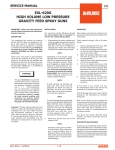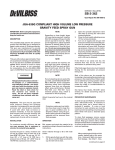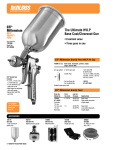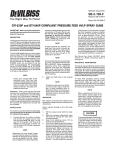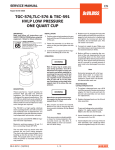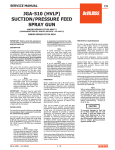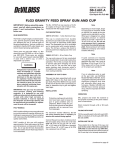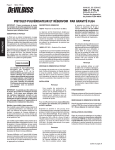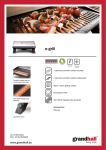Download SB-2-202-F - DeVilbiss
Transcript
SERVICE BULLETIN
SB-2-202-F
Replaces SB-2-202-E
Repair Kit KK-5058-2
EXL-620G HIGH VOLUME LOW PRESSURE
GRAVITY FEED SPRAY GUNS
IMPORTANT: Before using this equipment,
read all safety precautions and instructions.
Keep for future use.
DESCRIPTION
The compliant high volume low pressure
gravity feed EXL guns are designed to apply a wide variety of finishing materials.
These guns were manufactured to provide
a maximum transfer efficiency by limiting air
cap pressure to 10 psi (complies with rules
issued by SCAQMD and other air quality
authorities).
These guns will produce approximately
10 psi air cap pressure at 30 psi gun inlet
pressure. Air cap test kits are available (see
Accessories) which can be utilized to set the
exact air cap pressure. Air consumption for
the EXL-620G (#2000 cap) is 15.5 SCFM at
10 psi air cap presssure.
This gun should not be used with
chlorinated solvent materials.
Halogenated hydrocarbon solvents
(for example: methylene chloride
and 1, 1, 1, - Trichloroethane)
are not chemically compatible
with the aluminum that might be
used in many system components.
The chemical reaction caused
by these solvents reacting with
aluminum can become violent
and lead to equipment explosion.
See page 2 for potential hazards.
Important: This gun may be used with most
common coating and finishing materials. It
is designed for use with mildly corrosive
and non-abrasive materials. If used with
other high corrosive or abrasive materials,
it must be expected that frequent and thorough cleaning will be required and the
necessity for replacement of parts will be
increased.
INSTALLATION
For maximum transfer efficiency, do not
use more pressure than is necessary to
atomize the material being applied.
1.
Connect the gun to a clean, moisture and
oil free air supply using a hose size of at
least 5/16" I.D. hose. Do not use 1/4" I.D.
hose (25' x 1/4" hose at 18 CFM has a
pressure loss of 25 psi. 25' x 5/16" hose
at 18 CFM has a pressure loss of 8 psi).
Note
Depending on hose length, larger
I.D. hose may be required. Install an
HAV-501 air gauge at the gun handle
and air cap test kit over tip. When
gun is triggered on, adjust regulated
pressure to desired setting to provide a maximum of 10 psi at the air
cap. Do not use more pressure than
is necessary to atomize the material
being applied. Excess pressure will
create additional overspray and
reduce transfer efficiency.
Note
If quick connects are required, use
only high flow quick connects
approved for HVLP use such as
DeVilbiss HC-4419 and HC-4699.
Other types will not flow enough air
for proper gun operation.
Note
If an air adjusting valve is used at the
gun inlet, use DeVilbiss Model HAV500 or HAV-501. Some competitive
adjusting valves have significant
pressure drop that can adversely
affect spray performance. Models
H AV- 5 0 0 a n d H AV- 5 0 1 h a v e
minimal pressure drop, which is
important for HVLP spraying.
2. Attach the gravity feed cup to the
material inlet.
Note
Protective coating and rust inhibitors have been used to keep the
gun in good condition prior to
shipment. Before using the gun,
flush it with solvents so that these
materials will be removed from
fluid passages.
OPERATION
Mix, prepare and strain the material to be
sprayed according to the paint maufacturer's
instructions.
Strain material through a 60 or 90 mesh
screen.
1.
If used, install paint liner into cup. (See
instructions included with cup.)
2. Fill the gravity feed cup with the material. Do not overfill. Make sure that the
cup lid vent hole is clear.
3. Open the spreader adjustment valve
(10) (Fan) by turning the valve stem
counterclockwise.
4. Close the fluid needle adjusting screw
(17) by turning clockwise.
5. Turn on air supply and set gun inlet
pressure to lowest recommended pressure for material being sprayed. Best
atomization will occur with 10 psig air
cap pressure. However, some materials can be sprayed at lower pressures,
improving transfer efficiency.
6. Spray a test area by turning fluid
needle adjusting screw (17)
counterclockwise until a full coat is
obtained.
If the finish is too sandy and dry,
the material flow may be too low for the
atomization air pressure being used.
If the finish sags, there is too much material
flowing for the atomization air pressure
being used.
Both of the above can be corrected by
increasing or decreasing the atomization air
pressure or the material flow. Pattern width
can be altered by turning spreader adjustment valve (10), either clockwise to decrease the width or counterclockwise to
increase the width.
See Spray Gun Guide, SB-2-001 latest
revision, for details concerning setup of
spray guns.
PREVENTIVE MAINTENANCE
To clean air cap and fluid tip, brush exterior
with a stiff bristle brush. If necessary to clean
cap holes, use a broom straw or toothpick if
possible. If a wire or hard instrument is used,
extreme care must be used to prevent scratching or burring of the holes which will cause
a distorted spray pattern.
Page 2
SB-2-202-F
SAFETY PRECAUTIONS
This manual contains information that is important for you to know and understand. This information relates to USER SAFETY and
PREVENTING EQUIPMENT PROBLEMS. To help you recognize this information, we use the following symbols. Please pay particular
attention to these sections.
NOTE
Important safety information - A hazard
that may cause serious injury or loss
of life.
Important information that tells how
to prevent damage to equipment, or
how to avoid a situation that may cause
minor injury.
CA PROP
The following hazards may occur during the normal use of this equipment.
Please read the following chart before using this equipment.
65
Information that you should pay special
attention to.
PROP 65 WARNING
WARNING: This product contains chemicals
known to the State of California to cause
cancer and birth defects or other
reproductive harm.
HAZARDCAUSE
SAFEGUARDS
Fire
Adequate exhaust must be provided to keep air free of
accumulations of flammable vapors.
Solvent and coatings can be highly
flammable or combustible especially when
sprayed.
Smoking must never be allowed in the spray area.
Fire extinguishing equipment must be present in the spray area.
Solvent Spray
During use and while cleaning and flushing,
solvents can be forcefully expelled from fluid
and air passages. Some solvents can cause
eye injury.
Wear eye protection.
Inhaling Toxic Substances
Certain materials may be harmful if inhaled,
or if there is contact with the skin.
Follow the requirements of the Material Safety Data Sheet
supplied by your coating material manufacturer.
Adequate exhaust must be provided to keep the air free of
accumulations of toxic materials.
Use a mask or respirator whenever there is a chance of inhaling
sprayed materials. The mask must be compatible with the material
being sprayed and its concentration. Equipment must be as prescribed by an industrial hygienst or safety expert, and be NIOSH
approved.
Explosion Hazard Incompatible Materials
Halogenated hydrocarbon solvents - for
example; methylene chloride and 1,1,1,
- Trichloroethane are not chemically
compatible with the aluminum that might
be used in many system components. The
chemical reaction caused by these solvents
reacting with aluminum can become violent
and lead to an equipment explosion.
Due to the aluminum passageways in these guns, they must not
be used with these solvents. Aluminum is also widely used in
other spray application equipment – such as material pumps, regulators, valves and cups. Check all equipment items before use and
make sure they can also be used safely with these solvents. Read
the label or data sheet for the material you intend to spray.
If in doubt as to whether or not a coating or cleaning material is
compatible, contact your material supplier.
General Safety
Improper operation or maintenance of
equipment.
Operators should be given adequate training in the safe use
and maintenance of the equipment (in accordance with the
requirements of NFPA-33, Chapter 15). Users must comply with
all local and national codes of practice and insurance company
requirements governing ventilation, fire precautions, operation,
maintenance, and housekeeping. These are OSHA Sections
1910.94 and 1910.107 and NFPA-33.
Cumulative Trauma
Disorders ("CTD's")
Use of hand tools may cause cumulative
trauma disorders ("CTD's").
Pain, tingling, or numbness in the shoulder, forearm, wrist,
hands, or fingers, especially during the night, may be early
symptoms of a CTD. Do not ignore them. Should you experience
any such symptoms, see a physician immediately. Other early
symptoms may include vague discomfort in the hand, loss of
manual dexterity, and nonspecific pain in the arm. Ignoring early
symptoms and continued repetitive use of the arm, wrist, and
hand can lead to serious disability. Risk is reduced by avoiding or
lessening factors 1-7.
CTD's, or musculoskeletal
disorders, involve damage
to the hands, wrists,
elbows, shoulders, neck,
and back. Carpal tunnel
syndrome and tendonitis
(such as tennis elbow or
rotator cuff syndrome) are
examples of CTD's.
CTD's, when using hand tools, tend to affect
the upper extremities. Factors which may
increase the risk of developing a CTD include:
1. High frequency of the activity.
2. Excessive force, such as gripping,
pinching, or pressing with the hands and
fingers.
3. Extreme or awkward finger, wrist, or arm
positions.
4. Excessive duration of the activity.
5. Tool vibration.
6. Repeated pressure on a body part.
7. Working in cold temperatures.
CTD's can also be caused by such activities
as sewing, golf, tennis, and bowling, to name
a few.
SB-2-202-F
To clean fluid passages, remove excess
material from cup, then flush with a suitable
solvent. Wipe gun exterior with a solvent
dampened cloth. Never completely immerse
in solvent as this is detrimental to the lubricants and packings.
Page 3
Chart 1
PARTS REPLACEMENT
Figure 1 Air Cap
Air Cap No.
No. XXX
No. on Air Cap
Order
Air Cap With Ring
(Ref. No. 4) 2000
GTI-407-2000
Chart 2
Note
Fluid
Tip No.
When replacing the fluid tip or
fluid needle, replace both at the
same time. Using worn parts can
cause fluid leakage. See Chart 2.
Also, replace the needle packing
at this time. Lightly lubricate the
threads of the fluid tip before reassembling. Torque to 15-20 ft. lbs.
Do not overtighten the fluid tip.
Maximum air pressure required to
assure compliance of 10 PSI Max.
Cap Pressure - this reading must
be taken at the spray gun handle
inlet fitting.
Air cap covered by U.S.A. Patent
No. 6,293,476.
JGA-4035 Packing Replacement Instructions
Needle
SPRAY GUN LUBRICATION
Daily, apply a drop of SSL-10* spray gun
lube at trigger bearing stud (28) and the
stem of air valve (20) where it enters air
valve assembly. The shank of fluid needle
(11) where it enters packing nut (9) should
also be oiled. Fluid needle packing (8)
should be lubricated periodically. Make
sure baffle (6) and retaining ring (3) threads
are clean and free of foreign matter. Before
assembling retaining ring to baffle, clean
the threads thoroughly, then add two drops
of SSL-10 spray gun lube to threads. Fluid
needle spring (14) and air valve spring (19)
should be coated with a very light grease,
making sure that any excess grease will not
clog the air passages. For best results, lubricate the points indicated, daily.
* Not for air tools or high RPM equipment.
A. Trigger Points
B.Packing
C. Adjusting Knobs
D. Baffle Threads
E. Air Valve Cartridge
A
GTI-213-150.059
GTI-213-160.063
GTI-213-180.070
GTI-213-220.086
HVLP: 30 PSI
MAX. INLET
To prevent damage to fluid tip (5)
or fluid needle (10), be sure to
either 1) pull the trigger and hold
while tightening or loosening the
fluid tip, or 2) remove fluid needle
adjusting screw (16) to relieve
spring pressure against needle
collar.
C
D
E
B
Tip Size I.D.
In.
mm
1.5
1.6
1.8
2.2
#2000 Millennium Air Cap
Inlet
Pressure*
(PSI)
Cap
Pressure
(PSI)
8
14.5
20
24.5
30
*At handle of gun.
2
4
6
8
10
CFM
Flow**
(CFM)
7.5
10.5
12.5
14.5
15.8
**Fan fully open.
GTI-33 Baffle Seal Replacement
1. Remove Fluid Tip (5).
2. Remove Baffle (6).
3. Remove Seal (7) from baffle.
Gun Body
Packing
(3 pieces)
Packing
Nut
Note
The seal is designed to be a tight
fit on the baffle. The seal should be
able to be removed using your
fingers. If you are unable to remove the seal using your fingers,
insert a small screwdriver between
the outer lip and the back of the
baffle and pry the seal off.
1. Remove adjusting knob and needle
spring from gun.
2. Partially withdraw needle from gun
body.
3. Loosen packing nut and remove.
4. Remove old packing.
5. Assemble packing nut to needle
ANGLED SIDE
6. Assemble packing in order shown to
SEAL
needle.
7. Insert needle all the way into gun
body seating in tip.
8. Install needle spring and adjusting
knob.
THICK SIDE
9. Thread packing nut into gun body.
10. Tighten packing nut in equal
Pry here if
Baffle
increments - no more than
necessary
1/6 turn at a time.
11. After each adjustment, pull needle
open and observe needle closure.
12. In needle snaps shut, continue
adjusting nut until there is evidence
of needle bind or slow closing.
13. Back off packing nut 1/12 turn to
the point where needle snaps shut.
4. Assemble seal to baffle with angled side
Packing nut must remain tight
up as shown above. NOTE: The seal
enough to prevent loosening by
should be a tight fit on the baffle. If it is
hand.
a loose fit on the baffle, assure that it is
14. Pull needle several times to verify
assembled with the angled side up.
needle snaps shut and check packing
5. Install baffle on gun.
nut for looseness.
6.Install fluid tip (5) and tighten to
15-20 ft-lbs.
Page 4
SB-2-202-F
18
14
12
17
16
15
13
10
11
32
33 34 35
36
6
7
37
5
4
*26 Air Inlet Nipple
1/4" NPS(M)
(Torque to 15 ft.lbs.)
Use medium strength thread
sealant (i.e. Devcon #2242
Blue, or equal) on threads
2
1
3
Fluid Tip
(Torque to
15-20 ft.lbs.)
20
19
8
9
28
12
22
30
25
PARTS LIST
Ind.
Ref. Replacement
Parts
No. Part No.
Description
Req.
1 ---
2 JGA-156-K10
3 GTI-3
4 See Chart 1
5 See Chart 2
6 GTI-425
•7 GTI-33-K5
•8 JGA-4035-K5
9 34411-122-K10
10 GTI-404
11 GTI-413
•12 JGS-72-K10
13 ---
•14 ---
•15 ---
16 MBD-19-K10
17 GTI-414
18 KK-5059
•19 ---
•20 ---
Air Cap
Spring Clip (Kit of 10)
Air Cap Retaining Ring
Air Cap & Retaining Ring
Fluid Tip
Baffle Assembly
Baffle Seal (Kit of 5)
Packing (Kit of 5)
Packing Nut
Spreader Valve
Fluid Needle
Gasket Kit ( PTFE)
(Kit of 10)
Body Bushing
Fluid Needle Spring
Spring Pad
Spring and Pad
(Kit of 10)
Needle Adjusting Screw
Bushing, Spring, Pad
and Knob Kit
Air Valve Spring
Air Valve
31
27
21
24 23
29
1
1
1
1
1
1
1
1
1
1
1
2
1
1
1
1
1
1
1
1
Ind.
Ref. Replacement
Parts
No. Part No.
Description
Req.
21 ---
•22 ---
•23 ---
•24 ---
25 JGS-449-1
26 P-MB-51
27 ---
28 ---
29 JGS-478
30 ---
31 JGS-477-1
•32 KGP-13-K5
•33 ---
•34 ---
•35 ---
36 GTI-428-K5
37 192219
Air Valve Body
U-Cup Seal
Washer
Snap Ring
Air Valve Assembly
Air Inlet Nipple
1/4" NPS(M)
Trigger Stud Screw
Trigger Stud
Stud and Screw Kit
(Includes 3 Studs & 5 Screws)
Trigger
Trigger Stud, Screw Kit (1 each)
Cup Gasket (Blue) (Kit of 5)
Retaining Clip
Seal
Pin
Clip, Seal & Pin Kit (5 each)
Gun Holder, Coated
1
1
1
1
1
1
1
1
1
1
1
1
1
1
1
1
1
• KK-5058-2 Gun Repair Kit includes a quantity of necessary parts.
Sufixes -K5, -K10 designate kits of multiple parts.
Example: JGA-4035-K5 is a kit of 5 packings.
SB-2-202-F
TROUBLESHOOTING
Condition
Heavy top or
bottom pattern
Heavy right or left
side pattern
Cause
Correction
Horn holes plugged.
Obstruction on top or bottom of fluid tip.
Cap and/or tip seat dirty.
Clean. Ream with non-metallic point.
Clean.
Left or right side horn holes plugged.
Dirt on left or right side of fluid tip.
Clean. Ream with non-metallic point.
Clean.
Page 5
Clean.
Remedies for the top-heavy, bottom-heavy, right-heavy, and left-heavy patterns:
1. Determine if the obstruction is on the air cap or the fluid tip. Do this by making a test
spray pattern. Then, rotate the cap one-half turn and spray another pattern. If the defect
is inverted, obstruction is on the air cap. Clean the air cap as previously instructed.
2. If the defect is not inverted, it is on the fluid tip. Check for a fine burr on the edge of the
fluid tip. Remove with #600 wet or dry sand paper.
3. Check for dried paint just inside the opening; remove by washing with solvent.
Heavy center pattern
Fluid flow too high for atomization air.
Material flow exceeds air cap's capacity.
Spreader adjustment valve set too low.
Atomizing pressure too low.
Material too thick.
Balance air pressure and fluid flow. Increase
spray pattern width with spreader adjustment
valve.
Thin or lower fluid flow.
Adjust.
Increase pressure.
Thin to proper consistency.
Split spray pattern
Atomization air pressure too high.
Fluid flow too low.
Spreader adjusting valve set too high.
Reduce at transformer or gun.
Increase fluid flow (increases gun handling
speed).
Adjust.
Jerky or fluttering spray
*Loose or damaged fluid tip/seat.
Baffle seal installed incorrectly.
Material level too low.
Container tipped too far.
Obstruction in fluid passage.
Dry or loose fluid needle packing nut.
Tighten or replace.
Install per directions.
Refill.
Hold more upright.
Backflush with solvent.
Lubricate or tighten.
Unable to get round spray
Spreader adjustment screw not seating
properly.
Air cap retaining ring loose.
Clean or replace.
No air pressure at gun.
Check air supply and air lines, blow out gun
air passages.
Open fluid needle adjusting screw.
Will not spray
Fluid needle adjusting screw not open
enough.
Fluid too heavy for gravity feed.
Tighten.
Thin material and/or change to larger tip size.
Paint bubbles in cup
Fluid tip not tight.
Tighten tip to 12-15 ft-lbs.
Fluid leaking or dripping from
cup lid
Cup lid loose.
Dirty threads on cup or lid.
Cracked cup or lid.
Push in or tighten lid.
Clean.
Replace cup and lid.
Starved spray pattern
Inadequate material flow.
Low atomization air pressure.
Back fluid adjusting screw out to first thread,
or change to larger tip size.
Increase air pressure and rebalance gun.
Excessive overspray
Too much atomization air pressure.
Gun too far from work surface.
Improper stroking (arcing, gun motion too
fast).
Reduce pressure.
Adjust to proper distance.
Move at moderate pace, parallel to work
surface.
Excessive fog
Too much or too fast-drying thinner.
Too much atomization air pressure.
Remix properly.
Reduce pressure.
Dry spray
Air pressure too high.
Gun tip too far from work surface.
Gun motion too fast.
Gun out of adjustment.
Reduce air pressure.
Adjust to proper distance.
Slow down.
Adjust.
Fluid leaking from packing nut
Packing nut loose.
Packing worn or dry.
Tighten, do not bind needle.
Replace or lubricate.
Fluid leaking or dripping from
front of gun
Packing nut too tight.
Dry packing.
Fluid tip or needle worn or damaged.
Foreign matter in tip.
Fluid needle spring broken.
Wrong size needle or tip.
Adjust.
Lubricate.
Replace tip and needle.
Clean.
Replace.
Replace.
*Most common problem.
Page 6
SB-2-202-F
TROUBLESHOOTING (continued)
Condition
Cause
Correction
Fluid dripping or leaking from
bottom of cup
Cup loose on gun.
Cup gasket worn or missing below cup.
Cup threads dirty.
Tighten.
Replace cup gasket.
Clean.
Runs and sags
Too much material flow.
Material too thin.
Gun tilted on an angle, or gun
motion too slow.
Adjust gun or reduce fluid flow.
Mix properly or apply light coats.
Hold gun at right angle to work and
adapt to proper gun technique.
Thin, sandy coarse finish drying
before it flows out
Gun too far from surface.
Too much air pressure.
Improper thinner being used.
Check distance. Normally approx. 8".
Reduce air pressure and check spray pattern.
Follow paint manufacturer's mixing instrs.
Thick, dimpled finish "orange peel"
Gun too close to surface.
Check distance. Normally approx. 8".
Too much material coarsely atomized.
Increase air pressure or reduce fluid flow.
Follow paint manufacturer's mixing instrs.
Air pressure too low.
Improper thinner being used.
Material not properly mixed.
Surface rough, oily, dirty.
Properly clean and prepare.
SB-2-202-F
Page 7
ACCESSORIES
GFC-501 (Acetal) 20 Oz. Cup
GFC-502 (Aluminum) 1-Liter Cup
Gravity Feed Cups
These gravity feed cups
are designed to be used
with EXL, FLG, GFG,
GFHV or GTI gravity feed
spray guns.
GTI-5033-2000
Air Cap Test Kit
The purpose of this test
kit is to measure air cap
atomizing air pressure at
the center air port of the air
cap. Used to confirm code
compliance and as a daily
quality control measure.
Spray Gun Lube
SSL-10-K12 (2 oz. bottle)
Compatible with all paint materials;
contains no silicone or petroleum
distillates to contaminate paint.
MSDS Sheet available upon request.
HAV-500 OR
HAV-501
Adjusting Valve
(HAV-501 SHOWN)
HAV-500 does not
have pressure gauge.
Use to control air
usage at gun.
Cleaning Brushes
42884-214-K5 (3/8")
42884-215-K10 (5/8")
These brushes are
helpful in cleaning
threads and recesses
of gun body.
Industrial Quick Connects
for HVLP Guns (Air)
HC-4419
1/4" NPS(F)
HC-4699
1/4" NPT(M)
HC-4700
1/4" NPT(F)
JGA-156-K10
Spring Clips
29-3100-K6 Scrubs®
Hand Cleaner Towels
Joins any single
piece DeVilbiss
air cap with latest
version MBC-368,
MSA-1 or GTI3 retaining rings.
Helps prevent parts
loss and provides
easier assembly.
Scrubs® are a premoistened hand cleaner
towel for painters, body
men and mechanics that
go where you go and no
water is needed.
GH-505
Gun Holder
GH-407
Gun Holder
HC-1166
1/4" NPT(M)
WR-103 Wrench
Contains all necessary tip, hose and
nut sizes used on
or with gun.
OMX-70-K48 Paint Cup Liner Kit
Allows quick & easy clean-up.
Consists of : 1 - Piercing Tool,
48 - Disposable Liners, 48 - Drain Bushings
Gun holders are
made to hold standard paint cups, gravity feed guns and
cups, and paint filters.
(1) Wall mount bracket
included with GH-407.
Holds standard paint cups,
gravity feed guns and
cups, and paint filters.
Paint Spray Respirators
40-141 (Sm) 40-128 (Med) 40-143 (Lg)
NIOSH-Certified for respiratory protection in
atmospheres not immediately dangerous to life.
Page 8
SB-2-202-F
WARRANTY
This product is covered by DeVilbiss’ 1 Year Limited Warranty.
DeVilbiss Sales and Service: www.devilbiss.com
U.S.A./Canada Customer Service
195 Internationale Blvd.
Glendale Heights, IL 60139
630-237-5000
Toll Free Customer Service
and Technical Support
800-992-4657
Toll Free Fax
888-246-5732
1/12 © 2012 DeVilbiss All rights reserved. Printed in U.S.A.








